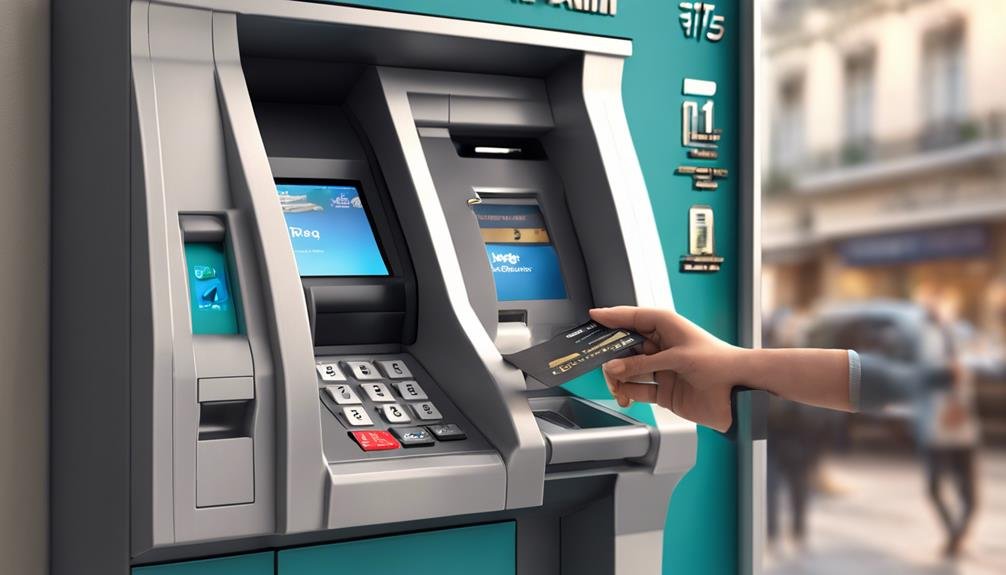What Is an ATM and How Does It Work?
Have you ever wondered how those ubiquitous ATMs you see at banks, convenience stores, and even airports actually function? From dispensing cash to facilitating deposits, ATMs play a vital role in modern banking. But have you ever stopped to ponder the intricate mechanisms behind these machines and how they securely handle your transactions? You might be surprised at the technological sophistication that goes into making these everyday conveniences work seamlessly for millions of users worldwide.
Key Takeaways
- ATMs are automated machines for financial transactions like withdrawals and deposits.
- Users access ATMs with a bank card and a unique Personal Identification Number (PIN).
- ATMs connect to the bank's network to process transactions securely.
- Cash withdrawals are dispensed from the ATM's secure cash dispenser.
- ATM transactions are recorded and receipts are provided for documentation.
ATM Functionality and Transactions
When using an ATM, you can easily conduct various banking transactions such as cash withdrawals, deposits, bill payments, and account transfers. To guarantee your transactions are secure, ATMs are equipped with various security measures such as PIN entry requirements, card encryption technologies, and surveillance cameras.
Additionally, ATM transaction limits are put in place to safeguard against fraudulent activities and to protect both the user and the bank. These limits may vary depending on the ATM provider and the type of transaction being conducted.
Types of ATMs and Features
As you explore the world of ATMs further, it becomes paramount to understand the diverse types of ATMs available and their corresponding features.
Basic ATMs offer cash withdrawals and balance inquiries, while more complex machines allow deposits, credit payments, and transfers. Advanced features often necessitate an account with the operating bank.
Additionally, there are Bitcoin ATMs that facilitate cryptocurrency transactions globally, with over 28,000 units available.
When considering ATM options, it's important to be aware of ATM security measures and the vast reach of global ATM networks. These security measures help protect your transactions and personal information, while the global networks ensure accessibility to your funds wherever you may be.
Essential Design Components of ATMs
To comprehend the intricate workings of ATMs, understanding the essential design components is key for users seeking insight into the machine's functionality. Security features are integral to ATM design, with components like the card reader ensuring secure access by reading card chips or magnetic stripes.
The user interface plays an important role, with the keypad allowing users to input their PIN, transaction type, and amount, while the screen guides them through transactions and displays account information. Additionally, the cash dispenser securely dispenses bills from a safe, and the printer provides transaction receipts for user records.
These design elements work together seamlessly to provide a secure and user-friendly experience at the ATM.
Insights Into ATM Usage and Benefits
Insights into ATM usage and benefits reveal the practical advantages and considerations for users managing banking transactions. ATMs offer a myriad of benefits, including global accessibility, allowing you to access your funds conveniently across different countries. This accessibility is particularly useful for travelers needing local currency quickly.
Additionally, ATMs provide a secure means of withdrawing cash, conducting transfers, and making deposits outside of traditional banking hours. Understanding the benefits of ATMs can help you make informed decisions about your financial transactions, ensuring efficiency and convenience.
Whether you need to withdraw cash for daily expenses or transfer money to a friend, ATMs offer a convenient solution with global reach, making banking transactions more accessible and streamlined.
Evolution of ATMs and Industry Resources
Amidst the dynamic landscape of financial technology, the evolution of ATMs and the resources within the industry continually shape the way individuals interact with banking services.
Key Points:
- ATM Security Advancements: With the rise in cyber threats, ATMs have seen significant security upgrades like biometric authentication, end-to-end encryption, and anti-skimming technology.
- Banking Industry Trends: The banking sector is moving towards more digital solutions, impacting ATM functionalities and integrations with mobile banking apps.
- Resource Support: Various industry resources such as regulatory guidelines, industry publications, and research data aid in the development and standardization of ATM technologies to meet customer demands securely and efficiently.
The evolution of ATMs not only reflects technological advancements but also aligns with the shifting landscape of consumer needs and banking industry trends.
Conclusion
To sum up, ATMs have revolutionized the way we handle our finances, providing convenience and accessibility to banking services worldwide. With their user-friendly interface, security measures, and range of transaction options, ATMs have become an indispensable tool for individuals looking to manage their money outside of traditional banking hours.
As technology continues to advance, the evolution of ATMs will likely bring even more innovative features and benefits to customers in the future.







